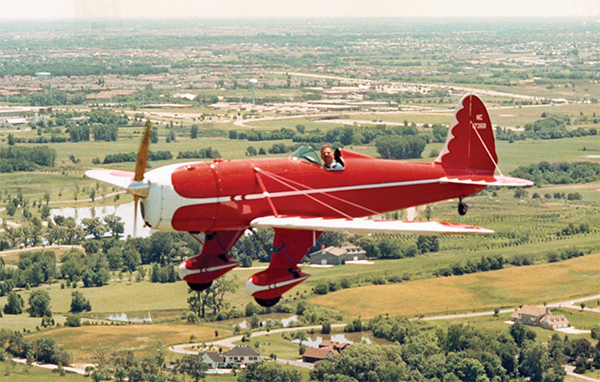
Yesterday’s story about South Barrington is based on research from a variety of sources by Barbara L. Benson. For perspective on today and tomorrow, and to learn about the spirit of South Barrington, read Mayor Paula McCombie’s article below, scroll to view.
In 1957, Bill Rose was flying over the countryside around Chicago. He was looking for an area to raise his family away from the city where his life was dominated by the family business, Rose Packing Company. His flight took him in a northwesterly exurban direction, and his view from the air was of farmsteads in their symmetrical patterns of pioneer times. More recently, in mid-20th century, a new type of pioneer—gentlemen farmers—had taken advantage of available land at reasonable prices, and their manicured country properties were intermittent punctuation marks in the area of Barrington Township that would later become the Village of South Barrington.
New on the landscape was the ribbon of the not-yet-completed Northwest Tollway, winding onward along the Fox River Valley toward Elgin and Rockford. It followed another of those indigenous and early military trail routes that went on to Freeport, Illinois and Wisconsin. The impact of the new 76-mile section of I-90, which would formally open on August 20, 1958, was already apparent to the east and south, where new high-density residential communities adjacent to commercial, industrial, retail, office, and research developments were quickly swallowing up the land. Hoffman Estates east to O’Hare Airport would become known as the Golden Corridor.
Aerial views in 1957, especially to the north and northwest of the snow-covered winter landscape, summon the imagination to the land’s flatness and bleakness. Broken up by only a few stands of timber, the earliest settlers began moving into this area in the mid-1830s and after. George Waterman arrived in 1842. He had served in the Massachusetts Light Infantry in the War of 1812. Traveling west with his large family, they joined the many settlers from the vicinity of North and South Adams in Massachusetts, who had gravitated to the township that in an 1840 consensus was named Barrington. It was believed Great Barrington in the Berkshires was a staging area for the westward bound pioneers. Charles Church, Nelson and David Messer, Lysander Beverly, Philip Hawley and many of his 12 children, and Shubuel Kingsley and his family were among those who brought with them the experience of serving in town and county government in the East, providing the knowledge to establish local government in their new home.
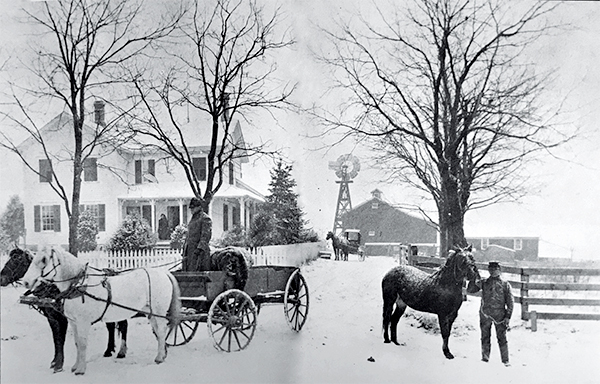
The Waterman School on Penny Road and the Miles Church house on Penny Road are surviving landmarks of that early period. The Hendrickson/Humphrey School built around 1860 on Algonquin Road near Witt Road was moved after school consolidation began in the 1940s, becoming part of a house on Penny Road.
A notable feature of the Humphrey School, according to one of its last teachers, Laura Witt, was a reed organ. This was purchased by the School District for an early teacher, May Andrews from Chicago, who started a Sunday school in the schoolhouse where students enjoyed the instrumental accompaniment to their singing. The Waterman School, first a log building, was replaced with the standard balloon frame school building around 1886. It was sold at the time of consolidation and remains a residence to this day. The Miles Church house was the backdrop for one of the first known photographs taken in the Barrington area. It shows the family outside in the winter of 1865.
The official Land Sales Office for Northern Illinois opened in Chicago in 1840. Settlers could now purchase the land that many of them had laid claim to. Paying $25 an acre, they were no longer squatters. Early plat maps give us their names and the acreage they acquired. Soon, Yankees of English, Irish, and Scottish heritage were joined by Germans. Plat maps tell the story, and most notable in the southeast quarter of Barrington Township was the Fred Mundhenke family. A genealogy compiled by Barrington’s foremost historian, Arnett C. Lines, documents their origins in Hanover, Germany and arrival in America in 1845. Three generations lived along the road that would engrave their name on the landscape of South Barrington.
For almost a hundred years, agriculture sustained the families that lived in Barrington Township. Travel was along the original stage and mail routes, until the Illinois and Wisconsin Railway founded the Village of Barrington Station to the north in 1854. Barrington’s first postmasters lived along Algonquin Road, which was then the Chicago to Freeport stage and mail route. Both George Waterman and Jerome Kingsley were Postmasters in 1854 and 1855, before all postal service was transferred to the new Barrington Station.
Grain, cattle, produce, and poultry were the mainstays of livelihood for the farmers. It was a hard existence. Blacksmiths and wagon makers were necessary to country life, however they gravitated to the new Village of Barrington after its founding. There, goods could be marketed, and the route was more direct than driving to Dundee, Algonquin, or even Elgin—the river towns established in the first years of settlement. The transformation of the countryside around the Village of Barrington began in the early 20th century when Sanford Peck opened a real estate office in the Railway Exchange Building in Chicago, selling large farms in Barrington to successful men in the railway industry. Within a few years, several thousand acres had been transformed into country estates and gentlemen’s farms, and two country clubs, Biltmore and Barrington Hills were social centers for a new generation of residents with city and North Shore backgrounds. Often, the farmers who had sold their land became managers of the new estates. They were invaluable as they knew the soils and the seasons. Some continued living in their old houses while the new owners brought in architects and builders to construct more spacious residences.
The May 23, 1937, edition of the Chicago Sunday Tribune carried the following headline: “Barrington District Proves Lure to Farm Minded Dwellers of Chicago and Suburbs”. It detailed with names and a coded map the 14,000 acres bought by city people in the previous four years, totaling 126 properties. Prices ranged from $125 to $1,500 an acre. For some new owners their properties were summer and weekend residences. With reliable train service from Barrington, a few lived permanently in the country and commuted into the city.
An early commuter was George Fairweather who was business manager for the University of Chicago. His 160-acre estate, purchased in 1935, was along Mundhank Road west of Barrington Road. Neighbors with several hundred acres included Mr. and Mrs. Harold C. Holbrook, a well-known cattleman. A wealthy and glamorous couple, Mr. and Mrs. Fowler McCormick, purchased “440 acres on the Penny Road, attractively landscaped and improved with a modern farmhouse type of residence” according to the Tribune. (See the sidebar ahead for Fifi and Fowler McCormick’s background and time in South Barrington.)
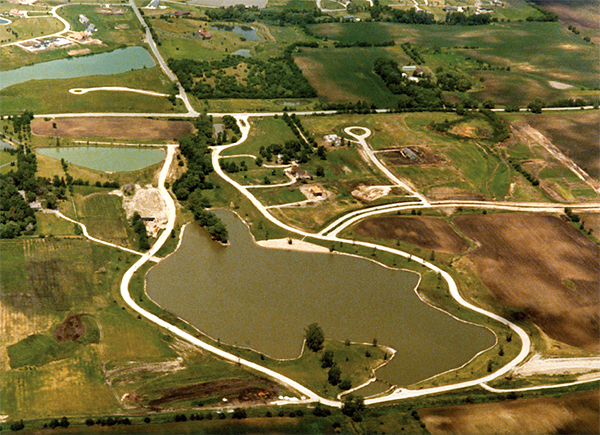
As he scoured the countryside by plane and car in 1957, William R. Rose was at one of his life’s crossroads. Born in 1927 in Corry, Pennsylvania, his parents were William R. Rose and Adalyn Kitson Clinkenbeard Rose. Part of his childhood was spent in New York City, where he often wandered at will. In 1934, the family moved to Evanston. His grandfather, Louis, founded the meatpacking business that would carry the family name. When Louis died, Bill’s father and his uncle took over the business. The younger Bill, unsettled at school and somewhat of a prankster, found himself back in Pennsylvania, enrolled in Valley Forge Military Academy. On February 20, 1945, after finishing at Valley Forge, he enlisted in the Marine Corps, shortly before his 18th birthday. This was the first of many self-described crossroads in his life.
His tour of duty with the Marine Corps must have presaged his future, because he began saving money to buy land. First it was an acre or two, quickly reaching 60 acres deep in the woods around Winchester, Northern Wisconsin. Any extra money often earned at Saturday night boxing matches went into buying land. Bill wanted to build a cabin on the land and live like Thoreau “far from the madding crowd”.
His second crossroads was declining the Marine Corps’ offer to send him to Officer Candidate School. In the fall of 1946, he resigned from the Marines, and after a visit with his parents purchased a jeep, a cement mixer, and a 36-inch buzz saw, and set off for Winchester to build his cabin. On his return to Chicago to enroll in Northwestern Technical School, he found relations between his father and uncle at the packing company had become strained. The future seemed bleak.
In the meantime, Bill Rose reached his third crossroads when he met Barbara Blanchard, who was a copy editor for a Chicago advertising agency. They were married on June 19, 1948 and soon after, they left for Bill’s cabin in Winchester. He always acknowledged the culture shock she experienced in the primitive living conditions. After she became pregnant, they returned to Evanston for the birth, which coincided with the breakup of the senior Rose Brothers partnership at the packing company and a threatened sale.
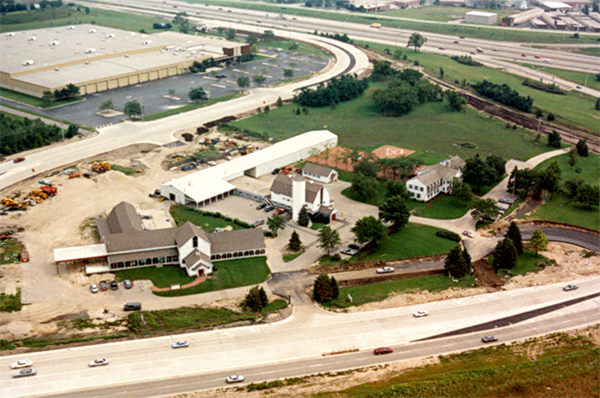
There was no return to the cabin. Bill was hired by Rose Packing Company and working with one of his father’s most trusted assistants, Walter Gleason, set about resurrecting the company. The following years of working day and night would bring their rewards, and in 1957, Bill Rose was flying over the fields of Barrington Township in a renewed quest for land. And the land was there with willing sellers. The McCormicks and the Holbrooks still owned considerable acreage, but George Fairweather had been selling. His farmhouse on a gentle rise off West Mundhank Road was already owned by Ned Twerdahl, who in turn sold the house with 20 acres to Bill Rose. In 1958, Bill, Barbara, and their three children moved in, and began transforming the property into a comfortable family home, Millrose Farm.
Rose soon acquired 500 adjacent acres and with associates another 500 acres in the area. As they made future land use plans, the opening of the Northwest Tollway and the improvement of Route 72 brought developers to the doorstep of the still rural land south of the Village of Barrington. One group sought to organize a village called Barrington Countryside
with quarter-acre lots. Rose and his neighbors responded quickly. He, Fred T. Kramer, Bill Brough, Laura Witt, Hans Seegers, and Ferris Gaskol hired attorney Andrew Dahlstream, who had been pivotal in the incorporation of the Village of Barrington Hills. A petition was formalized and filed at the Cook County Building with minutes to spare ahead of the other group. Later, Bill Rose would be proud to say that the Village of South Barrington was born at his kitchen table.
On December 12, 1959, a general election was held to seat the first Village of South Barrington Board of Trustees, and to elect the first Village President who was Fred Kramer. The first trustees were Bill Brough, Laura Witt, Al Weiman, Hans Seegers, and Art Hogfelt. They established minimum lot zoning at 1 ½ acres. Bill Rose formed a construction company which built The Glen, The Coves, and Sunset Ridge Farms subdivisions. Mundhank, Witt, Wichman, and Penny Roads provided a historical context for the new village. The subdivisions, with their winding roads, spacious lots, and covenants that defined the range of architectural styles, were further beautified through the imagination of Bill Rose, as his tractors sculpted out a series of lakes and waterfalls. To the east of Millrose Farm, in The Glen, the largest lake was named for his mother, Adalyn. Street names reflected his Scottish and pioneer Midwestern ancestry. In its maturity, the extensive landscaping of both public and private property has created a beautiful and gracious environment.
In the early 1960s, a leap of faith was required for new residents in the still somewhat barren landscape to buy into upscale properties. Almost everything “Barrington” was to the north. The schools, the library, the churches, and emergency medical services were in Elgin. Grocery stores were south on Barrington Road in Hoffman Estates or north in Barrington. Those new residents, mostly professionals, quickly shaped their new community. The South Barrington Club, initially through tennis and swimming, provided a social center for family recreation. The Garden Club of South Barrington offered a creative resource as lawns were manicured out of farm fields, trees were planted, and parkways bloomed with spring bulbs. The Barrington Park District and Homeowners Associations also fostered a sense of community. The Rose family donated over a thousand photographs to the History Collections at the Barrington Area Library which can be viewed online. From the early aerial photos of the still open fields, to the construction of the lake and the waterfall in The Glen, to the mature landscaping surrounding the residences, many of which resemble English manor houses, they document the community’s growth.
The new Tollway, and thousands of still unincorporated acres, created pressures on the village to protect its borders from rampant commercial development. In the July/August 2017 issue of Quintessential Barrington, an article about the Barrington Area Council of Governments lists many of the “super project” proposals that would have negatively impacted especially South Barrington. Fighting the Accelerator project cost the village $100,000 in legal fees. (See the sidebar, titled “What Might Have Been”.)
As the village annexed more land, residential development increased. In 1973, Bill Rose purchased 17 acres on Barrington Road, close to the Tollway off-ramp. Here the conversion of an old farmhouse was the nucleus for the permanent corporate headquarters of Rose Packing Company. The second floor provided space for the first South Barrington Police Department of which Rose was a member. On this site too, Rose began to consolidate what was undoubtedly the signature commercial enterprise in South Barrington. Millrose Country Store originated in “the coop”, a small building where meals were prepared for workers in the area, using Rose Packing products, and a demand developed for the sale of meats and other goods.
Ever practical, Rose saw uses for the old barns being abandoned in the area. The Country Store and the subsequent Millrose Brewing Company and Restaurant all credited their unique ambience to Bill Rose, as he moved historic barns to the site. By 1998, a total of six barns formed what the Restaurants and Institutions Magazine designated as the 67th largest restaurant in the United States. Its reputation for good food in a convivial environment drew patrons from a wide area.
In 1972, there was another commercial addition that reflected South Barrington’s rural heritage. Jim Goebbert purchased a 40-acre farm on Higgins Road and moved his family there from Arlington Heights. In 1973, his children began selling pumpkins on the roadside, drawing huge crowds, and the Fall Festival was born. In 1979, the farm was brilliantly landmarked by the addition of an 18 ft. wide fiberglass pumpkin on top of the silo. “Happy Jack” is not to be missed, and to this day, many a family outing is enjoyed at Goebbert’s Fall Festival.
Alexander Stillman, son of “Fifi” McCormick, had received 80 acres from his mother’s property and in 1976, he donated it to The Chicago Audubon Society. It would become the Stillman Nature Center, valued prairie preserves offering educational programs and outdoor events.
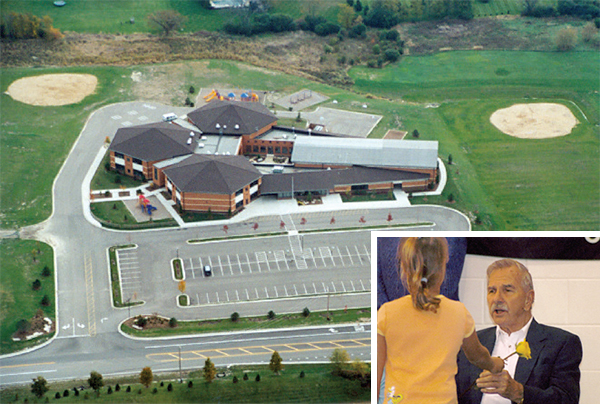
In 1981, remarkable change occurred when Willow Creek Community Church, one of the largest inter-denominational churches in the country, acquired available land at the southeast corner of Barrington and Algonquin Roads. An expanding campus set in lakes and lawns gradually increased attendance to almost 17,000 people on weekends. South Barrington also annexed residential areas east of Barrington Road. However, this controlled development served to protect the core community. In 1998, another commercial activity adjoined the village when a 30-screen movie complex was opened at the northwest corner of Barrington Road and the Tollway.
The year 1998 was truly memorable year for the Village, when thanks to the generosity of Bill Rose, Barrington Unit District 220 opened the Barbara B. Rose Elementary School on Penny Road named in honor of Bill’s first wife. Young children were no longer bussed north into Barrington.
Mayor Paula McCombie writes about the South Barrington of today and tomorrow, but there is one more unique time in history to be recalled. Bill Rose had early on developed a passion for flying. He collected storied airplanes and had a commercial pilot’s license. Alongside Millrose Farm, he laid out an airstrip and built hangars for a Grumman Goose, an FNJ Navy trainer, and several Ryans. He was a proud member of EAA Chapter 790, and with his flying friends, Rose’s Raiders, attended the Oshkosh Air Shows for 25 years.
In the summers of the 1980s and until 1992, the skies over South Barrington came alive with the colors of the small planes as they flew in and out of Bill Rose’s airstrip, culminating in the invitational “Fly In”, a day of friendship, feasting, and the joy of flight. The hospitality extended by Bill Rose to all his neighbors reflected that the village founded at his kitchen table had become a good place to live. The epitaph for Sir Christopher Wren in St. Paul’s Cathedral is well known: “If you seek his monument, look around you.” The same could be said of Bill Rose and South Barrington, and the subsequent Village governments and residents who have sought to uphold his vision.
From 1970 onward, Barrington area communities pooled resources through the Barrington Area Council of Governments (BACOG) when development proposals incompatible with their visions for their individual communities came knocking. For South Barrington, the “southern gateway” to the Barrington area, those incompatible threats were considerable.
Even before BACOG was formed, the Centex Company proposed 1,800 residential units on 500 acres. The proposal was beaten back, and the area would become South Barrington Lakes.
In the early 1970s, another major land use proposal was the Beverly project. Unincorporated areas between South Barrington and Hoffman Estates would become a new city, with 6,000 housing units, and industrial and office parks along the Northwest Tollway. Eventually much of this land was annexed into Hoffman Estates.
Through the 1970s, plans to co-opt Barrington’s open spaces continued to emerge. Senator Paul Douglas proposed South Barrington as a site for a National Accelerator Research Lab. At first there was local interest. When Barrington Hills residents became fully aware of the size of the proposal and asked whether such a large government facility was appropriate for the area, there was a groundswell of opposition and combined with strong political pressure, the proposal was withdrawn. The land is now part of the Spring Creek Forest Preserve.
Next was a landfill proposal for the Klehm Nursery. Claims that the perimeter of the landfill would not impact residences were deemed misleading. Columns of garbage trucks on local roads, and environmental and groundwater contamination in an area dependent on individual well water were among factors that were deemed detrimental to South Barrington and Barrington Hills.
Another attempt to gain outside control of open space within the Barrington area occurred in the 1980s when The Chicago Farmers, with interest from the Cook County Forest Preserve, proposed a Living History Farm in the Spring Creek Forest Preserve which would have drawn hundreds of thousands of visitors a year. An outstanding political effort took care of this proposal, and later the southern land use was resolved to become the Sears Headquarters and the Prairie Stone Business Park.
There are still areas where land use issues arise, especially between South Barrington and Hoffman Estates, but Village governments and BACOG have achieved expertise in dealing with each situation for acceptable outcomes. (Excerpted from the July/August 2017 issue of Quintessential Barrington.)
For Bill Rose’s story, read the chapter in Diane Kostick’s book, “Voices of Barrington” published in 2002 by Arcadia Publishing, Inc. Some of the information in this article is drawn from her book and gratefully acknowledged. Also, a February 20, 1992 Chicago Tribune article by Kay Schwerzler offers a colorful history of Rose Packing Company. Reminiscences were also shared with Dwight Stiehl, Walter Gleason’s son-in-law, who was president and CEO at Rose Packing Company for 15 years until the company’s sale in 2019 to OSI Group. He is now a senior advisor to OSI based at Rose’s offices in South Barrington.
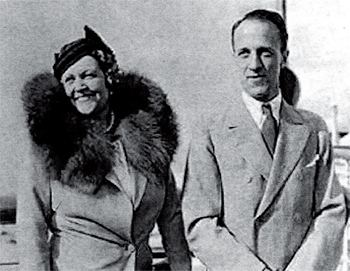
On May 23, 1937, the Chicago Sunday Tribune published an article by Al Chase headlined “Barrington District Proves Lure to Farm Minded Dwellers of Chicago Suburbs”. Over 100 farm properties totaling 14,000 acres had been purchased by families of wealth and note for country retreats, hobby farms, and practical farms. Among those were Mr. and Mrs. Harold Fowler McCormick, Jr. They bought 440 acres on Penny Road [that was] “attractively landscaped and improved with a modern farmhouse style of home”.
It was a simple statement, but the background of Mr. and Mrs. Fowler McCormick, Jr. was far from simple. Their marriage in 1931 was the culmination of years of rumor and family saga that had fascinated high society and headlined the front pages of major newspapers. McCormick, Rockefeller, and Stillman were the famous names that caused this furor.
The bride at Pleasantville, New York in June 1931 was 51-year-old Mrs. Anne Urquhart Potter (FiFi) Stillman, newly divorced form James A. Stillman, former president and largest stockholder of National City Bank, founded by his father.
The bridegroom was 32-year-old Harold Fowler McCormick, Jr., the son of Harold Fowler McCormick, and the grandson of Cyrus Hall McCormick, inventor of the reaper. Harold Jr.’s mother was Edith Rockefeller, daughter of Standard Oil co-founder John Davison Rockefeller.
Family, fame, and fortune, and the bride and groom’s age difference—and the bridegroom a Princeton roommate of the former Mrs. Stillman’s son, James A. “Bud” Stillman—all propelled curiosity in the drama. The two young men had also sought to produce evidence against Mr. Stillman when he first tried to divorce Anne in 1920. After years of reconciliations and separations between the Stillmans, Anne obtained a secret divorce hours before she married Fowler McCormick, Jr.
They lived in Chicago. The bridegroom was an executive in his family’s International Harvester Company, and in their circles, a country estate was de rigueur. The McCormick’s neighbors along Penny Road were Mr. and Mrs. Harold C. Holbrook, who owned about 200 acres. Fifi remained close to the sons of her marriage to James Stillman, and in 1938, her youngest son, Guy, married the Holbrook’s daughter, Nancy.
After the Second World War, Fifi’s second son, Alexander Stillman, was deeded 80 acres of the McCormick property and built a residence close to his mother. A Harvard graduate, “Aleck” spent most of his life traveling, collecting antiques and curiosities. During World War Two he served in the Navy, receiving many commendations for his leadership and bravery in the Pacific Ocean theater. Later, he became devoted to the environment, which earned him a Certificate of Lifetime Membership in the National Audubon Society.
By the mid-1950s, his mother and stepfather had left Barrington for their enormous ranch in Scottsdale, Arizona. When Fifi died in 1969, the ranch covered almost seven square miles. Her husband died in Los Angeles in 1973.
Alexander Stillman died in January 1984. He was buried in the National Memorial Cemetery of the Pacific in Honolulu. The McCormick name is gone from South Barrington, but the Stillman Nature Center is the lasting legacy of two storied families whose stars collided more that 80 years ago.

The South Barrington of today is quite different from the South Barrington that was incorporated in December 1959. Most of the rural farmlands that once made up the landscape have now been transformed into a vibrant community providing countryside living close to the city. South Barrington is situated in a prime suburban location along the I-90 corridor, 35 minutes from downtown Chicago and 25 minutes from O’Hare International Airport.
With over 1,700 homes and approximately 5,000 residents, South Barrington is a community of neighborhoods that reflect the individuality of the residents that live within. When returning from a typical workday, residents decompress as they drive home along tree-lined roadways and past tranquil subdivision lakes.
A diverse array of attractions can be found in South Barrington. Perhaps one of the oldest landmarks along Rt. 72 and Higgins Road is Goebbert’s Farm and Garden Center with its “Happy Jack” pumpkin-topped silo. Drawing visitors to its fall festival, Goebbert’s is an annual tradition for many families. Just west of Goebbert’s along Higgins Road is South Barrington’s 500,000 square foot contemporary lifestyle center known as The Arboretum of South Barrington. The Arboretum is host to several entertainment venues, from bocce and bowling at Pinstripes, axe throwing at Bullseye Axe Lounge, to the latest movies at the iPic Theater. The Arboretum’s 65 retail stores, restaurants, and services provide a myriad of options for shoppers and diners. Concerts, farmer’s markets, a wine walk, yoga programs, car shows, and ice skating are just some of the events that take place at the new “Main Street Plaza” in the Arboretum.
Heading to the east end of town, on Barrington Road there are more restaurants and the AMC 24 theater. Additionally, South Barrington houses many medical and professional businesses in several office centers in town.
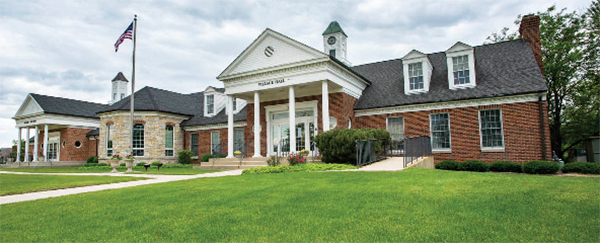
The 130-acre campus of Willow Creek Church, one of the largest nondenominational churches in the United States, is located at the corner of Barrington and Algonquin Roads in South Barrington. Willow Creek not only holds services, but also presents well-known annual leadership conferences and programs. Their two main auditoriums seat approximately 10,000 people. The church sponsors a robust Care Center that provides outreach services for people in need. Dental care, eye care, legal help, car repair, and a food pantry are among its offerings.
Quality schools and parks are essential partners and a source of community pride. Barrington 220 schools have won 11 National Blue Ribbons and numerous other education awards of merit. The South Barrington Park District offers a variety of memberships with indoor/outdoor tennis, paddleball, fitness classes, and organized sports programs using their soccer and baseball fields and indoor and outdoor pools.
South Barrington is known as a Green Power Community. Through green credits, the Village is the EPA’s 58th largest user of Green Electric Power in the nation. South Barrington ranks 3rd in the nation for the percentage of green credit sourced electricity usage, as well. Respecting the environment has been woven into the operations of the Village in many ways. For example, the Village paves local streets with warm asphalt to reduce emissions and extend the life of the roadways. Snow plowing with the latest high-tech equipment reduces the amount of salt used in winter. The Village has been designated with Gold status for its solar program to help residents and businesses install solar panels. The new Simple Recycling program provides easy curbside pickup for used clothing, rags, and other small items that otherwise would end up in a landfill. South Barrington further demonstrates its commitment to the environment with the Village owned “Conservancy”, a 20-acre passive park area showcasing a butterfly habitat, native plants, trees, and birds. The natural open space is a perfect setting for the conservation programs the Village has sponsored in conjunction with the local school district.
The future for South Barrington is very bright. Area development is increasing and is demonstrated by the cutting-edge technology companies lining up along the I-90 border taking advantage of both the proximity to O’Hare Airport and the synergy of their corporate neighbors. The demand and inquiries for available land is heating up. We routinely meet with developers on concept ideas for the vacant parcels in town. To better market the Village’s presence and promote improved communication, a new logo and website (southbarrington.org) have been designed.
On the threshold of a new decade, South Barrington is aware of the importance of defining itself and building on current success. The administrative and police department employees are focused on working with the public in a friendly and efficient manner. The Board and I continue to develop and nurture positive relationships with residents, businesses, and visitors to preserve the high quality of life experienced and enjoyed in South Barrington.
Mayor Paula McCombie graduated from the University of Wisconsin with a BS in Psychology and her professional background is in real estate. She has lived in South Barrington with her husband Michael for over 30 years. Their three sons grew up in South Barrington and attended Barrington 220 schools. McCombie was appointed to the Village’s Plan Commission from 2001-2004 and served as an elected Trustee from 2004-2013. First elected as Village President in 2013, she was reelected to her current term in 2017. Paula McCombie serves as a full-time mayor with a hands-on approach to leadership.
Share this Story